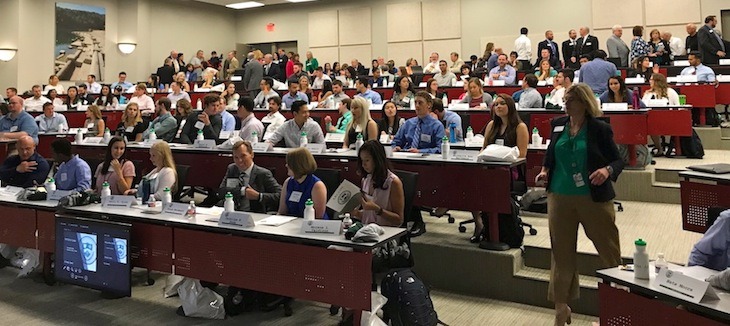Osteopathic college welcomes opening class: ‘The DNA of a community are in these walls’
by July 31, 2017 4:51 pm 3,809 views

The inaugural class of students at the Arkansas Osteopathic College of Medicine in Fort Smith gather for their opening session.
In 1887, George F. Degen, director of St. John’s Episcopal Church in Fort Smith, Ark., discovered a railroad worker had been horribly injured. Degen collected his hat and marched several paces down Garrison Avenue, what many considered to be the “end of civilization” before crossing over into the mostly lawless Oklahoma Territory.
Garrison was Fort Smith’s retail center in those days. It was also home to a string of brothels and bars that could be as rowdy on a bad day as the badlands Judge Isaac C. Parker and his U.S. Marshals oversaw.
Even so, Degen suspected there was a softer side to his community, and the hunch proved correct. He returned with $500 — enough money to rent a building and hire a physician to care for the injured man.
St. John’s Hospital was born.
DNA OF A COMMUNITY
Over the years, St. John’s would morph into Sparks Regional Medical Center (SRMC), a community-owned hospital that ran into its own set of financial needs 122 years later.
According to Degen Foundation treasurer and chairman of the Arkansas Colleges of Health Education (ACHE) Board of Directors John Taylor, “Sparks was bleeding money. In fact, we had hired two sets of attorneys … one in case we needed to file bankruptcy and close down the hospital, and the other to try and help us find someone to buy it.”
“Long story short,” Taylor told the inaugural class of 162 at the Arkansas College of Osteopathic Medicine (ARCOM) on Monday, July 31, “we were successful in selling the hospital.”
Initial hopes, Taylor said, were that “we got just enough money to pay everybody off.”
“There was a bond issue that was outstanding. There were a lot of other things that were unpaid. There were some pension funds that were unfunded. And through something I believe was providential, not coincidental, we sold the hospital and ended up with about $60 million; thus was birthed the Degen Foundation.”

It was this 2009 sale of Sparks to Naples, Fla.-based Health Management Associates (HMA) that made ARCOM and the ACHE possible, Taylor said, referring to the $63.629 million the Foundation has had restricted for ACHE use since prior to 2015. As of June 30, 2015, the Foundation reported total assets of $74.843 million.
“The DNA, the lifeblood of this community, goes back 130 years. It is in these walls today. It’s in all this fancy cable that makes this technology work,” Taylor said.
In welcoming remarks on Monday, ACHE President and CEO Kyle Parker, said there were “a lot of people to thank” for making the day — and the institution’s inaugural year — happen. Parker credited the cities of Fort Smith and Barling as well as the Fort Chaffee Redevelopment Authority (FCRA) for getting the college off the ground with zoning help and land donations. He also praised “the people I can’t name” for anonymous donations that made the recently announced research facility and $15 million Arkansas College of Health Sciences (ACHS) possible.
“Rare events come occasionally in life. Historic events only happen once in a lifetime,” Parker said. “In 25 years, we’ll be saying, ‘This was the opening day of the Arkansas College of Osteopathic Medicine.’ This is an historic event.”

And to the class of 2021, Parker said, “You’re the first class that took a chance to come to a brand new medical school. … You’ve come here because you believe in a mission. We weren’t just trying to fill seats. You’re the top 150 out of 3,860 (students that applied). You’re a special, special group of people, and I am just thrilled beyond all belief you’ve chosen to come here and be with us.”
SERVING THE UNDERSERVED
From inception, Rev. Degen’s mission was to serve the underserved, and that concept made it into the school’s mission statement. It’s what drew students like Samantha Skinner, who admitted as much to Talk Business & Politics.
“That’s really a big reason why I chose ARCOM. It’s in their mission statement, and they tell you that when you walk through the door.”
Skinner said that was a “big part of my life” as a little girl and young woman, following her mother — a trauma and ER registered nurse — into third world Guatemala.
“There are so many things in Guatemala that happened. Being there and helping one patient, you can change not only their physical well-being, but also their economic well-being. You can help patch up a leg, and that man can go back to work and he can feed his family, just by being independent,” Skinner said. “That’s the one thing that really drew me to medicine. I’m not just helping a person fix a broken finger. I’m helping them get back to their lives. That’s what is important.”
Caroline Cosner, a transplant from nearby Gans, Okla., agreed. “If you can affect one life, you can affect hundreds of lives for years to come. I think that’s what really drew me to medicine.”
Cosner “followed the pre-med route” through college before “stepping out of her comfort zone” and moving to a rural area on the outskirts of Madrid, Spain, where she taught English. She recently returned to the U.S., just in time to make the move to ARCOM and credits an Oklahoma doctor for “taking me under his wing and encouraging me to apply.”
Cosner and Skinner also credited the community support for continuing a tradition that was so apparent the day Rev. Degen took his chances down Garrison Avenue.
“You can feel the community just thriving around us,” Skinner said. “It’s so genuine, and just a great feeling.”
